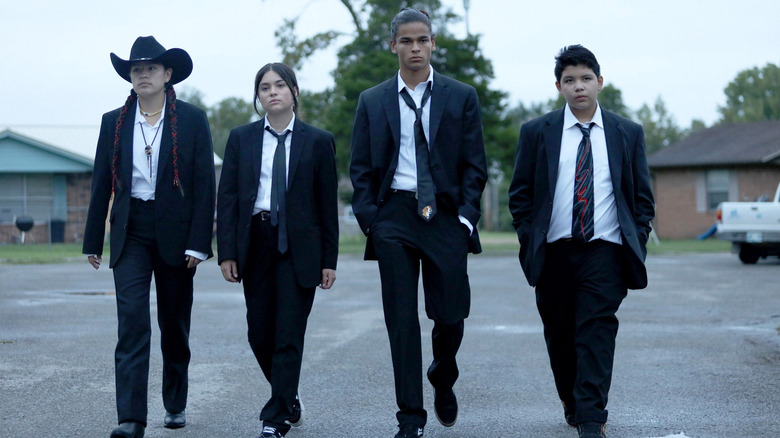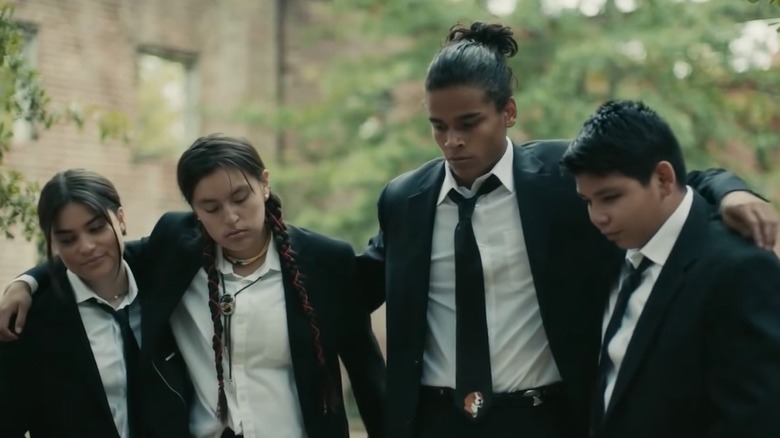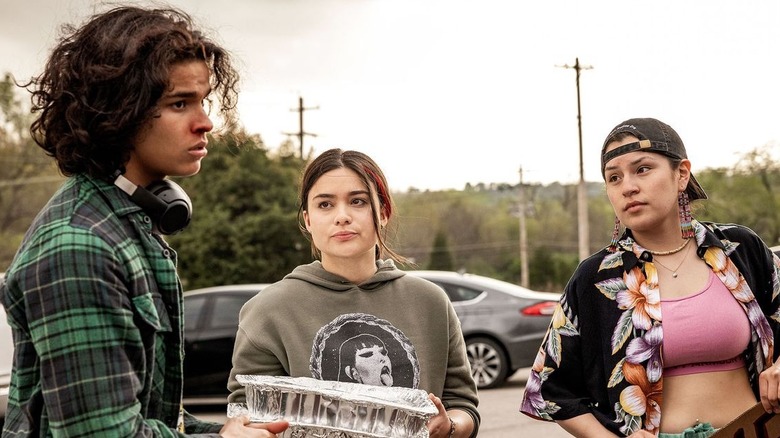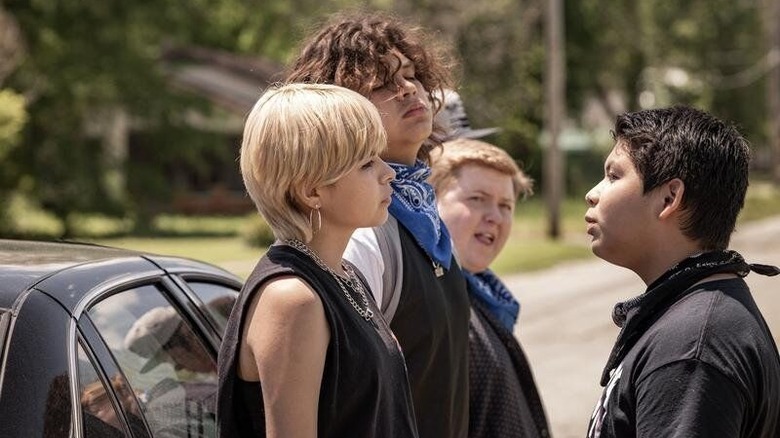
"Reservation Dogs" is another FX show that screams artistic freedom. There are no limits to the imagination. Season 1 can have a heartfelt moment between a mother and son, and somewhere else along the way, an homage to "Gladiator" and a music video for "Greasy Frybead." Writer-director Sydney Freeland is behind several of these unforgettable moments.
Freeland was in the writers room and directed several episodes, including "What About Your Dad" and "NDN Clinic." The filmmaker was born and raised on a Navajo reservation in Gallup, New Mexico, and with this series (which was co-created by Sterlin Harjo and Taika Waititi), Freeland got to tell personal stories with the FX comedy. Prior to working on "Reservation Dogs," Freeland directed "Drunktown's Finest" and "Deidra & Laney Rob a Train."
Recently, Freeland told us about her time working on "Reservation Dogs," making a show she wanted to see, and what to expect from season 2.
"It Just Started With Everyone Telling Stories."

How was shooting "Reservation Dogs" during the pandemic?
The expression coming in was, it never happened in Oklahoma, and I found that to be very true. And fortunately, I was fully vaccinated before I went out. I got fully vaccinated, first shot in January, second shot in March. Then I went out to Oklahoma at the end of March. I was fully vaccinated going into it. And on set, obviously very strict protocol, but then once you're driving around the community and everything, you'd walk in to restaurants and people were not wearing masks. It was wild. It was crazy because I had to go straight from "Reservation Dogs" to another TV show in Toronto, and it was night and day.
A lot of comedies are almost made to binge, but "Reservation Dogs" is one of the rare ones you want to take time watching. Did you think about how you hoped it'd be watched?
I think in the writers room, there was a lot of talk initially about, how do we frame the show? It was an all native writers room, right? There was no getting people up to speed or hand holding in the process. We all came from these indigenous communities and we all got to figure it out running. So obviously we had a lot of conversations up front, and basically what it boils down to is, "We don't want to make a TV show that we wouldn't want to see. We want to make a TV show that we would have wanted to see." That was the jumping off point. Then Sterlin Harjo gave us a ton of freedom, like if you've got an idea, go with it.
I think one example of that is, we had that Spirit (Dallas Goldtooth). He shows up at the beginning, but then he shows up again in the clinic, right? I said to Sterlin, "Hey what if we put just a little poster in the wall behind Spirit?" When you go to these Indian clinics they always have these random posters, and some of them have nothing to do with what you're in there for. We put it there and we don't make a big deal about it. It's there in the background. Maybe people catch it, maybe they don't, but that's fine. Sterlin said go for it. He gave us room to play. I think there might be some connection between what you're saying. There was so much creative freedom.
You see that in the show. You mentioned everyone making a show they wanted to see, not the show they didn't want to see, so what were some of the earliest ideas for how to accomplish that?
Talking about stories from our experiences growing up, you know? And obviously, we all know each other. We've worked with each other for years if not decades, so we've known each other for some years. It just started with everyone telling stories. "Oh, I remember when this happened growing up." "I remember that happened growing up." It was about that life from the reservation. 60 miles is not a long way on a reservation, because 60 miles is basically an hour away. So growing up I always had to drive an hour and a half to borrow a DVD from somebody. It was 90 miles away. I'd just drive 90 miles to my friend's house. "Hey can I borrow your DVD?" And then, "Yeah, sure. Bring it back whenever." That's the pace of life and everything. Everyone has their stories and that's where you get the character Punkin' Lusty (Sten Joddi).
I forget whose ideas Punkin' Lusty was. We were trying to think of this rapper's name, and then someone in the room said, "Why don't we call him Punkin'?" And then someone else said, "There's a Punkin' on my ranch." And then someone else says, "Well, we have a Punkin' on our ranch." I was the only one who was like, "I don't know any f*cking Punkin'." But if everyone has a Punkin', it's got to be Punkin'. It's just ingesting our own personal experiences and realizing how much we all have in common.
How did all the "Willow" references come about?
I know that predated the writers room. That was a Sterlin and Taika original. It was already in the pilot script. But then, we sort of just took things that were referenced and ran with them. There are other references.
"Godzilla" has a lot of meaning in the story, too.
Oh yeah. "Godzilla," I think that's for a sentimental choice for Sterlin, I believe. But a lot of that was just, we're all film fans, you know? We tried to put in shoutouts wherever we could. We're mostly children of the 80s, like, basically most American kids. We're Indian but we're also American. A lot of "Goonies" talk, a lot of "Willow" talk. Another movie that we referenced frequently was "Friday." For me, that was a staple. I did track and field in high school and we had track and field practice over spring break one year. We had an off day and all we did on an off day was watch "Friday." We watched "Friday" back-to-back.
How's it hold up? I haven't seen it in a while.
It holds up. It's just so good. But it just sort of encapsulated I think, again, certain framing of that where it's, like, the ghetto and LA. You can look at it through one lens, but through another lens, there are people living there that are rich and dynamic characters. We looked at this, like, can we apply that to this well?
"I Thought It'd Be So Cool To Do A Lo-Fi Hype Williams Aesthetic."

Visually, how'd you approach the show?
Basically, we had a very tight schedule, because of COVID, so we didn't have the normal amount of days, the normal amount of time to shoot. We were shooting an episode in 40 hours, which even for a half-hour show, that's pretty tight. We had to do a lot of pre-planning and whenever we had opportunities for a film reference, that was always a play. In the pilot, we reference "Platoon." I know in the second episode we did, like when Bear (D'Pharaoh Woon-A-Tai) gets knocked out, we recreated when Maximus dies in "Gladiator" and floats. It was just, "Yeah, let's just do that."
Even for the Punkin' Lusty video for "Greasy Frybed," in the script, it just said his rap video played. It was four lines of a song. Then, we got this great new rapper, Sten Joddi, who does fantastic work. We just said, "Hey, let's have him make the whole f*cking song." So, we reached out to him, and 48 hours later, we had a full song that had been sound mixed, edited, and everything. It was great. We gave it to all the writers and said, "We have to shoot this whole music video."
Again, talking about the style of that, I'm particularly influenced by the Hype Williams music videos, Busta Rhymes, Missy Elliot, and even someone like Nelly. I thought it'd be so cool to do a lo-fi Hype Williams aesthetic. We actually shot that whole music in four hours on a Saturday.
It's fantastic.
[Laughs] Good, good, good. You know, that music video was one of my favorite shoot days. The whole community came out. Sterlin's aunties and his mom were in the video. This didn't make it into the shoot, but at one point when we were shooting, all the aunties spontaneously broke down into this hymn, like this gospel hymn. It was this beautifully profound moment I'll always remember.
Later in that episode, there's a beautiful moment between Bear and his mom, Rita (Sarah Podemski), where she's just very honest and direct with him. Was shooting that a special moment for you as well?
Yeah. I think D'Pharaoh and Sarah nailed that dynamic. D'Pharaoh as an actor, he's just got this willingness to be open, this willingness to be vulnerable, which I think was the key to the character. We didn't talk about this specifically, I got the impression that those people kind of related to the situation. Once we went into it, it was about giving D'Pharaoh permission to go there and the faith to get in that headspace and go there. It was see what comes from it, you know? I think they got to a great place with it.
Going back to the music video, how'd you want to recreate the style of those '90s music videos you mentioned?
Honestly, I had no idea what to expect. I've seen Sten in some music videos, and I think his first real shooting was actually just the day before [the music video]. On Saturday, we said, "We got to shoot the music video now." He's like, "Well okay." As soon as we said "action," him and the camera just connected in such a way, and he's so performative. Within three seconds, it was like, "Oh, this is going to f*cking work. It's going to be great." I think my hope is that people have as much fun watching as we did shooting it.
"It Will Be Crazier Than The First Season."

With the episode set mostly in the clinic, what were the logistics of shooting it during the pandemic? Also, how'd you want to make that episode as cinematic as the rest of the series?
For myself, when I come into a TV show and I'm directing something, especially if we're shooting locations, you're always looking for that end point, you know? How can I frame this, so it doesn't look like a boring office, right? When we first got into it, that was our location scout. When we got into the lobby, it was a little underwhelming. It was an actual clinic, and again, it was very underwhelming. Then, when we went into the clinic for the eye check, I thought, "This is going to work." Basically, what you see in the episode, that's what we walked in on. Immediately walking into that I was like, "Oh sh*t. That's exactly like the one I grew up going to."
We said, "Okay. This is going to work as a backdrop." And then, we built everything up from there. Everything else fell into place. For me, it just provides this space for the actors so they feel comfortable, because you have this space for them, and they come in, and they elevate everything. So, you have the space and them in a space with Bobby Lee, you know?
It was great seeing him in that.
He had everyone cracking up. He started doing crowd work on our last day. So ,the last thing we shot of Bobby is actually a scene where it's just him out in the back, out behind the hospital and he's eating a chip and smoking. We're in between takes, and then Bobby starts doing crowd work with the group. It was so much fun.
Just him as a doctor, I don't know why, felt authentic to me.
[Laughs] Yeah. He's also the perfect embodiment because again, we're talking about our experiences growing up. That attitude that he has as a doctor, this is not inaccurate. The doctors at eye clinics are not there because they want to be.
With season 2 confirmed, where do you hope the show goes in the future?
I think we had probably 14 episodes, I want to say. We had ideas for 14 episodes and then we narrowed that down to eight. So, we already have plenty of ideas for season two. I know we have things we want to accomplish and places we want to go. It will be crazier than the first season.
Great. Thanks again for your time. I just want to say, it's always nice to see a show that feels exciting, you know?
Thank you. Thank you. I want to thank you because this is probably new material to 99% of people out there. But for us, who live in this environment or grew up in this environment, this is our daily lives, so it's actually very special to be able to share with an outside audience. Not only share with them but have them connect, it is very special.
Season 1 of "Reservation Dogs" is now streaming on Hulu.
Read this next: 15 Shows Like Brooklyn Nine-Nine You Need To See
The post Reservation Dogs Writer-Director Sydney Freeland Made the Show She Wanted to See [Interview] appeared first on /Film.
0 Commentaires